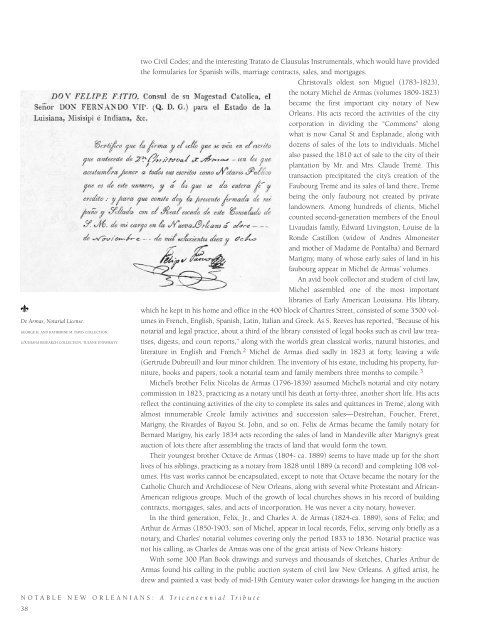Notable New Orleanians: A Tricentennial Tribute
An illustrated history of New Orleans paired with the histories of companies that have helped shape the city.
An illustrated history of New Orleans paired with the histories of companies that have helped shape the city.
Create successful ePaper yourself
Turn your PDF publications into a flip-book with our unique Google optimized e-Paper software.
De Armas, Notarial License.<br />
GEORGE H. AND KATHERINE M. DAVIS COLLECTION,<br />
LOUISIANA RESEARCH COLLECTION, TULANE UNIVERSITY.<br />
two Civil Codes; and the interesting Tratato de Clausulas Instrumentals, which would have provided<br />
the formularies for Spanish wills, marriage contracts, sales, and mortgages.<br />
Christoval’s oldest son Miguel (1783-1823),<br />
the notary Michel de Armas (volumes 1809-1823)<br />
became the first important city notary of <strong>New</strong><br />
Orleans. His acts record the activities of the city<br />
corporation in dividing the “Commons” along<br />
what is now Canal St and Esplanade, along with<br />
dozens of sales of the lots to individuals. Michel<br />
also passed the 1810 act of sale to the city of their<br />
plantation by Mr. and Mrs. Claude Tremé. This<br />
transaction precipitated the city’s creation of the<br />
Faubourg Tremé and its sales of land there, Tremé<br />
being the only faubourg not created by private<br />
landowners. Among hundreds of clients, Michel<br />
counted second-generation members of the Enoul<br />
Livaudais family, Edward Livingston, Louise de la<br />
Ronde Castillon (widow of Andres Almonester<br />
and mother of Madame de Pontalba) and Bernard<br />
Marigny, many of whose early sales of land in his<br />
faubourg appear in Michel de Armas’ volumes.<br />
An avid book collector and student of civil law,<br />
Michel assembled one of the most important<br />
libraries of Early American Louisiana. His library,<br />
which he kept in his home and office in the 400 block of Chartres Street, consisted of some 3500 volumes<br />
in French, English, Spanish, Latin, Italian and Greek. As S. Reeves has reported, “Because of his<br />
notarial and legal practice, about a third of the library consisted of legal books such as civil law treatises,<br />
digests, and court reports,” along with the world’s great classical works, natural histories, and<br />
literature in English and French. 2 Michel de Armas died sadly in 1823 at forty, leaving a wife<br />
(Gertrude Dubreuil) and four minor children. The inventory of his estate, including his property, furniture,<br />
books and papers, took a notarial team and family members three months to compile. 3<br />
Michel’s brother Felix Nicolas de Armas (1796-1839) assumed Michel’s notarial and city notary<br />
commission in 1823, practicing as a notary until his death at forty-three, another short life. His acts<br />
reflect the continuing activities of the city to complete its sales and quittances in Tremé, along with<br />
almost innumerable Creole family activities and succession sales—Destrehan, Foucher, Freret,<br />
Marigny, the Rivardes of Bayou St. John, and so on. Felix de Armas became the family notary for<br />
Bernard Marigny, his early 1834 acts recording the sales of land in Mandeville after Marigny’s great<br />
auction of lots there after assembling the tracts of land that would form the town.<br />
Their youngest brother Octave de Armas (1804- ca. 1889) seems to have made up for the short<br />
lives of his siblings, practicing as a notary from 1828 until 1889 (a record) and completing 108 volumes.<br />
His vast works cannot be encapsulated, except to note that Octave became the notary for the<br />
Catholic Church and Archdiocese of <strong>New</strong> Orleans, along with several white Protestant and African-<br />
American religious groups. Much of the growth of local churches shows in his record of building<br />
contracts, mortgages, sales, and acts of incorporation. He was never a city notary, however.<br />
In the third generation, Felix, Jr., and Charles A. de Armas (1824-ca. 1889), sons of Felix; and<br />
Arthur de Armas (1850-1903, son of Michel, appear in local records, Felix, serving only briefly as a<br />
notary, and Charles’ notarial volumes covering only the period 1833 to 1836. Notarial practice was<br />
not his calling, as Charles de Armas was one of the great artists of <strong>New</strong> Orleans history.<br />
With some 300 Plan Book drawings and surveys and thousands of sketches, Charles Arthur de<br />
Armas found his calling in the public auction system of civil law <strong>New</strong> Orleans. A gifted artist, he<br />
drew and painted a vast body of mid-19th Century water color drawings for hanging in the auction<br />
NOTABLE NEW ORLEANIANS: A <strong>Tricentennial</strong> <strong>Tribute</strong><br />
38
















